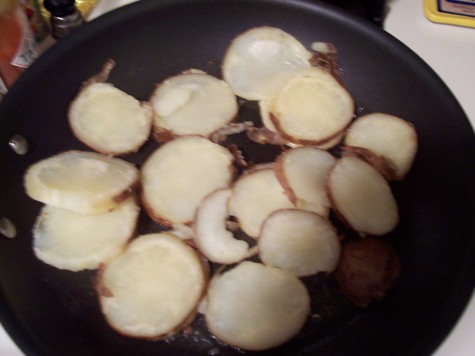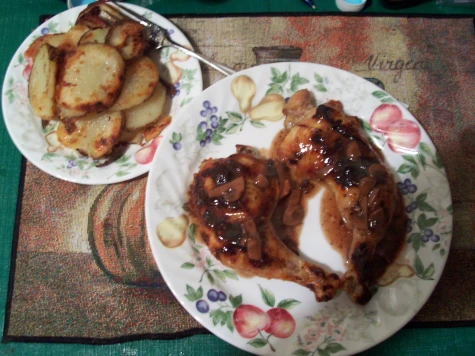Not all 18th Century cooking was needlessly complex. Hannah Glasse, the 18th Century’s Rachael Ray, gives this simple recipe for fried potatoes in The Art of Cookery Made Plain and Easy:
To Fry Potatoes: Cut them into thin slices as big as a Crown piece, fry them brown, lay them in a plate or dish, pour melted butter and sack and sugar over them. These are a pretty corner-plate.
You can essentially follow this recipe the same way in the modern kitchen, except that you should let the potato boil, and then simmer, in enough water to cover it until it’s tender before slicing it. You can find a more exact recipe in the extraordinarily useful Pennsylvania Housewife: English Household Receipts in the Middle Colonies.

The Pennsylvania Housewife suggests pouring your butter and wine over first, and then scattering sugar. My interpretation, however, is that Mrs. Glasse was talking about a sauce: in the preceding recipe for potato cakes, for instance, she lists the same three ingredients and specifically states that they’re to be combined. I went with sauce, using the following recipe from British Heritage’s Georgian Cookery, converted here for the convenience of my fellow Jonathans into Imperial measurements:
Wine Sauce
-
1 cup Sack or medium sherry
-
4 tbsp butter
-
1/8 cup sugar (the book uses caster, but substitute superfine for more hardcore 18th Century-ness)
Mix everything together and heat. Pour over or serve separately in a hot sauceboat.
This sauce sounds tremendously bad for you, and it is. The bright side is that you really only need a couple of teaspoonfuls of it to get the desired effect, and it does add a mild, sweet, but definitely wine-y flavor.
So what to have with potatoes? John Farley, master chef of the London Tavern (the Gordon Ramsay of his day), also recognized that sometimes the simple things are the best. From his 1783 London Art of Cookery:
To Broil Chickens: Having slitted your chickens down the back, season them with pepper and salt and lay them on the gridiron, over a clear fire and at a great distance. Let the inside continue next the fire, till it be nearly half done. Then turn them, taking care that the fleshy sides do not burn, and let them broil until they are of a fine brown. Have good gravy sauce, with some mushrooms, and garnish them with lemon, and the liver broiled, and the gizzards cut, slashed, and broiled with pepper and salt, or you may use any other sauce you fancy.

By the way: stealing one too many napkins from Farley’s restaurant in the 18th Century could get you sent to Australia. Modern restaurateurs, take note and advocate!